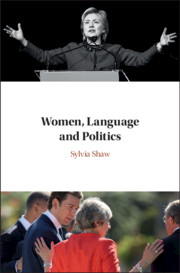Book contents
- Women, Language and Politics
- Women, Language and Politics
- Copyright page
- Dedication
- Contents
- Figures
- Tables
- Acknowledgements
- Abbreviations
- Transcription Conventions
- 1 Introduction
- 2 Gender and Language in Political Institutions
- 3 Women’s Linguistic Participation in a Traditional Male-Dominated Forum – The UK House of Commons
- 4 Women’s Linguistic Participation in the New Devolved Assemblies of the UK
- 5 Barriers to Women’s Participation in Politics
- 6 Case Study: Theresa May
- 7 Case Studies: Julia Gillard and Hillary Clinton
- 8 Women, Language and Politics
- Book part
- Notes
- References
- Index
5 - Barriers to Women’s Participation in Politics
Published online by Cambridge University Press: 08 May 2020
- Women, Language and Politics
- Women, Language and Politics
- Copyright page
- Dedication
- Contents
- Figures
- Tables
- Acknowledgements
- Abbreviations
- Transcription Conventions
- 1 Introduction
- 2 Gender and Language in Political Institutions
- 3 Women’s Linguistic Participation in a Traditional Male-Dominated Forum – The UK House of Commons
- 4 Women’s Linguistic Participation in the New Devolved Assemblies of the UK
- 5 Barriers to Women’s Participation in Politics
- 6 Case Study: Theresa May
- 7 Case Studies: Julia Gillard and Hillary Clinton
- 8 Women, Language and Politics
- Book part
- Notes
- References
- Index
Summary
This chapter examines the interlinked barriers to women’s participation identified by the ethnographic descriptions and analyses of parliamentary interaction in the first half of the book. First it considers the nature of stereotypes about gender and communicative styles and their effects on women politicians, in particular the ‘different voice’ ideology and the problems posed by beliefs in the masculine voice of authority in public contexts. These interactional styles are shown to be ideologically salient to the ways in which politicians evaluate political speeches, including their own. Secondly, it considers sexism and its effects by using examples from the House of Commons. This leads to a discussion of fraternal networks and homosocial bonding and the ways in which this can marginalise and exclude some groups. Finally, the underrepresentation and sexist framing of women politicians by the media is considered by reviewing existing international research literature and examples from the UK House of Commons, using a critical discourse analytic approach.
Keywords
- Type
- Chapter
- Information
- Women, Language and Politics , pp. 138 - 177Publisher: Cambridge University PressPrint publication year: 2020
- 1
- Cited by

